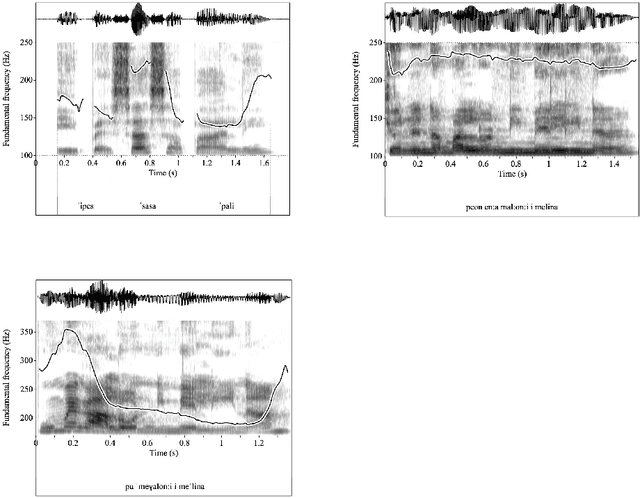Charalambos Themistocleous
Computational Language Assessment: Open Brain AI
Jun 11, 2023Abstract:Language assessment plays a crucial role in diagnosing and treating individuals with speech, language, and communication disorders caused by neurogenic conditions, whether developmental or acquired. However, traditional manual assessment methods have several drawbacks. They are often laborious and time-consuming to administer and score, causing additional patient stress. Moreover, they divert valuable resources from treatment. To address these challenges, we introduce Open Brain AI (openbrainai.com), a computational platform that harnesses innovative AI techniques, including machine learning and natural language processing, to automatically analyze spoken and written speech productions. The platform leverages state-of-the-art AI techniques and aims to present a promising advancement in language assessment. Its ability to provide reliable and efficient measurements can enhance the accuracy of diagnoses and optimize treatment strategies for individuals with speech, language, and communication disorders. Furthermore, the automation and objectivity offered by the platform alleviate the burden on clinicians, enabling them to streamline their workflow and allocate more time and resources to direct patient care. Notably, the platform is freely accessible, empowering clinicians to conduct critical analyses of their data and allowing them to allocate more attention to other critical aspects of therapy and treatment.
Computational Language Assessment in patients with speech, language, and communication impairments
May 31, 2023Abstract:Speech, language, and communication symptoms enable the early detection, diagnosis, treatment planning, and monitoring of neurocognitive disease progression. Nevertheless, traditional manual neurologic assessment, the speech and language evaluation standard, is time-consuming and resource-intensive for clinicians. We argue that Computational Language Assessment (C.L.A.) is an improvement over conventional manual neurological assessment. Using machine learning, natural language processing, and signal processing, C.L.A. provides a neuro-cognitive evaluation of speech, language, and communication in elderly and high-risk individuals for dementia. ii. facilitates the diagnosis, prognosis, and therapy efficacy in at-risk and language-impaired populations; and iii. allows easier extensibility to assess patients from a wide range of languages. Also, C.L.A. employs Artificial Intelligence models to inform theory on the relationship between language symptoms and their neural bases. It significantly advances our ability to optimize the prevention and treatment of elderly individuals with communication disorders, allowing them to age gracefully with social engagement.
Discourse and conversation impairments in patients with dementia
Dec 03, 2022Abstract:Neurodegeneration characterizes individuals with different dementia subtypes (e.g., individuals with Alzheimer's Disease, Primary Progressive Aphasia, and Parkinson's Disease), leading to progressive decline in cognitive, linguistic, and social functioning. Speech and language impairments are early symptoms in individuals with focal forms of neurodegenerative conditions, coupled with deficits in cognitive, social, and behavioral domains. This paper reviews the findings on language and communication deficits and identifies the effects of dementia on the production and perception of discourse. It discusses findings concerning (i) language function, cognitive representation, and impairment, (ii) communicative competence, emotions, empathy, and theory-of-mind, and (iii) speech-in-interaction. It argues that clinical discourse analysis can provide a comprehensive assessment of language and communication skills in individuals, which complements the existing neurolinguistic evaluation for (differential) diagnosis, prognosis, and treatment efficacy evaluation.
Sonorant spectra and coarticulation distinguish speakers with different dialects
Oct 07, 2021



Abstract:The aim of this study is to determine the effect of language varieties on the spectral distribution of stressed and unstressed sonorants (nasals /m, n/, lateral approximants /l/, and rhotics /r/) and on their coarticulatory effects on adjacent sounds. To quantify the shape of the spectral distribution, we calculated the spectral moments from the sonorant spectra of nasals /m, n/, lateral approximants /l/, and rhotics /r/ produced by Athenian Greek and Cypriot Greek speakers. To estimate the co-articulatory effects of sonorants on the adjacent vowels' F1 - F4 formant frequencies, we developed polynomial models of the adjacent vowel's formant contours. We found significant effects of language variety (sociolinguistic information) on the spectral moments of each sonorant /m/, /n/, /l/, /r/ (except between /m/ and /n/) and on the formant contours of the adjacent vowel. All sonorants (including /m/ and /n/) had distinct effects on adjacent vowel's formant contours, especially for F3 and F4. The study highlights that the combination of spectral moments and coarticulatory effects of sonorants determines linguistic (stress and phonemic category) and sociolinguistic (language variety) characteristics of sonorants. It also provides the first comparative acoustic analysis of Athenian Greek and Cypriot Greek sonorants.
Modelling prosodic structure using Artificial Neural Networks
Jun 15, 2017
Abstract:The ability to accurately perceive whether a speaker is asking a question or is making a statement is crucial for any successful interaction. However, learning and classifying tonal patterns has been a challenging task for automatic speech recognition and for models of tonal representation, as tonal contours are characterized by significant variation. This paper provides a classification model of Cypriot Greek questions and statements. We evaluate two state-of-the-art network architectures: a Long Short-Term Memory (LSTM) network and a convolutional network (ConvNet). The ConvNet outperforms the LSTM in the classification task and exhibited an excellent performance with 95% classification accuracy.
 Add to Chrome
Add to Chrome Add to Firefox
Add to Firefox Add to Edge
Add to Edge